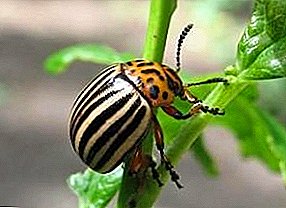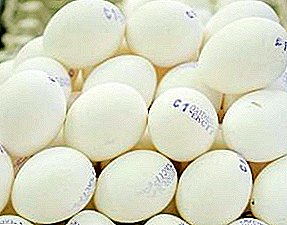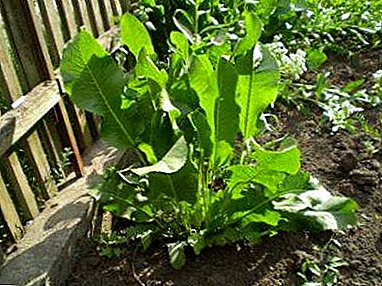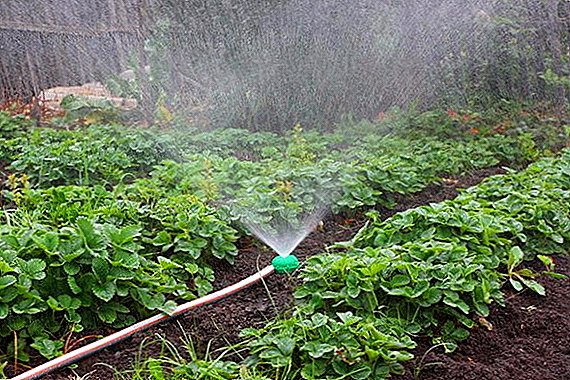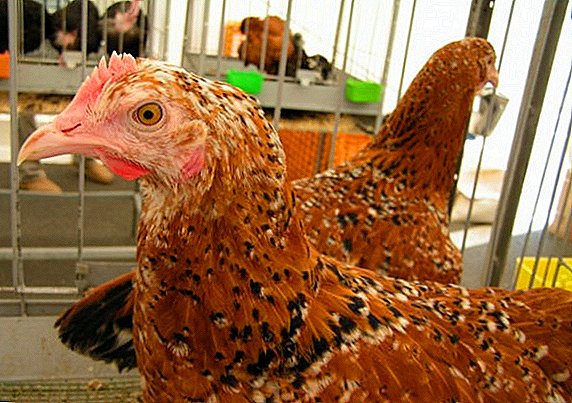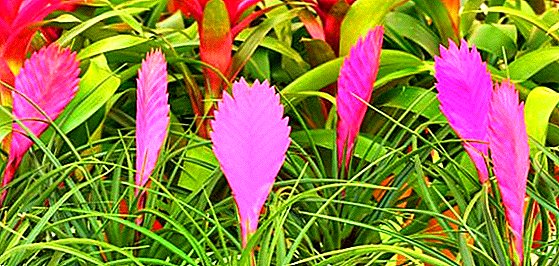 When you first meet with tillandse it seems that before the eyes painted plant. The fact is that the culture has a rather wayward form of flowers of the original color. It seems that its peduncle is cut out of colored paper and painted by an enthusiastic artist. So unusual and spectacular, it looks among the leafy greens. What is tillandsiya by itself, how to grow it and what standards of care to follow, all this we will consider in this article.
When you first meet with tillandse it seems that before the eyes painted plant. The fact is that the culture has a rather wayward form of flowers of the original color. It seems that its peduncle is cut out of colored paper and painted by an enthusiastic artist. So unusual and spectacular, it looks among the leafy greens. What is tillandsiya by itself, how to grow it and what standards of care to follow, all this we will consider in this article.
Meet the tropical guest
Tillandsia is a bright and unique inhabitant of tropical flora that represents the bromeliad family. This wonderful evergreen herb came to us from the tropics and subtropics. His homeland is America. Did you know? The plant once had a rather barbaric name that most gardeners didn’t like. In this regard, the Swedish naturalist Carl Linnaeus renamed the species, calling it the honor of the only famous Finnish florist Elias Tillands.
In the wild, according to different sources, there are from 400 to 700 varieties of epiphytic culture. Most of the representatives of the parasite on stones or trees, absorbs moisture from them and useful substances. Some species absorb moisture using scales on foliage.  Describing the look of tillandia is quite difficult, because the tropical guest is impressive with its originality and diversity. The most popular in our area are species with long dark green leaves, up to 35 cm long, sometimes scaly, and spike-shaped peduncles. Species with gray and red-brown leaves are particularly unique.
Describing the look of tillandia is quite difficult, because the tropical guest is impressive with its originality and diversity. The most popular in our area are species with long dark green leaves, up to 35 cm long, sometimes scaly, and spike-shaped peduncles. Species with gray and red-brown leaves are particularly unique.
Most tillands do not have stems, but some species still have them.  After flowering, the maternal rosette of leaves dies away, releasing young shoots before it.
After flowering, the maternal rosette of leaves dies away, releasing young shoots before it.
Important! With proper care, your tropical pupil will delight you with flowering in the second or third year of life. If she does not like something (for example, poor lighting, improper care), she may not bloom at all.
Indoor species
Our climatic norms, unfortunately, did not like Tillands. Therefore it is necessary to grow it in room conditions. And that, not all types. We list the most popular among flower growers:
- Tillandsiya Anita - a unique hybrid that has a high decorative effect. Narrow long leaves of the variety are painted in gray-green shades. Of particular interest and attention are the original flower stalks of the spike shape, on which bright blue three-petal flowers are placed, decorated with pale pink bracts. After the flowers wither, the spike with bracts for quite a long time makes the culture exotic.
- Atmospheric tillandsia - favorite flower growers. Thanks to this culture, your own home can turn into a small tropical corner. The plant attracts with its extraordinary appearance: it has no roots, absorbs moisture from the air with the help of scales on the shoots and leaves, and its gray-green stems, 25-30 cm long, hover and hang down in a cascade.
- The most popular grade of atmospheric species is tylandus, known as the old man’s beard, angel hair, Spanish moss. Such names are associated with associations that are caused by the appearance of the culture: capricious hair-stems, instead of hairpins, are decorated with pale yellow flowers. It should be remembered that for the full growth of usnevidnogo varieties necessary support, on which a cascade of stems will go down.



Did you know? Homeland "old man's beard" - South America, which was inhabited by Indians. Once the Spanish sailors sailed to the shores of the country. Having seen their beards, the American aborigines began to name curling tillandia in their honor.
Care and conditions in the house
Tillandsia - still that capricious. The procedure for growing such an unusual inhabitant, provides for the creation in the house climate as close as possible to the tropical. But, having studied in detail all the manners and whims of culture, observing the norms of caring for her at home, you will be able to admire the bloom of your pet in the second year of her life.
Lighting
The most important thing in caring for tillandia is choosing the right place in the house. Culture does not like direct sunlight.  The best corner for it in the summer are the northern window sills in the summer, and the western or eastern - in the winter. In the summer, it can also be placed on the glazed terrace or veranda, if necessary, pritenyat. Atmospheric species are able to tolerate rather poor lighting.
The best corner for it in the summer are the northern window sills in the summer, and the western or eastern - in the winter. In the summer, it can also be placed on the glazed terrace or veranda, if necessary, pritenyat. Atmospheric species are able to tolerate rather poor lighting. Important! Tillandsiya prefers the ongoing daylight hours. Therefore, in the winter it needs additional lighting. For such purposes, use ordinary fluorescent lamps.
Temperature
The optimum temperature in the room where the culture lives in the summer is + 20-24˚С, in the winter - + 18-20˚С. It is also worth regularly air the roombecause a guest from the tropics needs a constant supply of fresh air. But, in the process of airing to ensure that the plant does not fall on the draft, which adversely affects its livelihoods. Does not welcome the flower and sudden temperature jumps. 
Watering and moisture
Properly organized process of irrigation and maintaining the necessary level of humidity in the room is the key to success in the process of tillandsia care. However, when organizing this process, you should pay attention to varietal featuresbecause each species has its whims.
- Potted culture needs regular portions of moisture. It is necessary to ensure that the soil under it never dries out. In the summer, it is advised to water directly under the root outlet. In winter, light drying of the soil is permissible. In addition to watering, such a pupil should be sprayed with water every day, excluding flowering time.
- Lack of roots atmospheric species eliminates the need to water them. Such tillandsia should be regularly sprayed with water at room temperature. It is advisable to place near them pallets or other containers with water.
- Uneven variety advised to periodically immerse in a container of water. Especially in cases of dehydration, what the plant will tell you is twisted leaves.
 The norms of humidity in the tropical corner of your home should be 70-75%, and do not fall below 60%. Abundant and regular spraying is the most important rule for the care of tillandia.
The norms of humidity in the tropical corner of your home should be 70-75%, and do not fall below 60%. Abundant and regular spraying is the most important rule for the care of tillandia.If you want to arrange a small tropical corner in your house, pay attention to such plants: Strelitzia, Achmeia, Guzmania, Philodendron, Asplenium, Pepermia, Nephrolepis, Platiserium.
Top dressing
Choose fertilizers for thylandia pretty easy: it is either fertilizing for orchids or complex fertilizers for flowering crops. The dosage should be adjusted depending on the type of flower: pot varieties are advised to reduce the doses indicated in the instructions by 2 times, and epiphytic - by 4.  Regarding the graphics of fertilizing, experienced flower growers are advised to fertilize a tropical ward every two weeks in summer and spring.
Regarding the graphics of fertilizing, experienced flower growers are advised to fertilize a tropical ward every two weeks in summer and spring.
Important! It is recommended that the culture be fed in a foliar way, regardless of its type, that is, spray fertilizer on the foliage and stems.
When and how to bloom
Tillandsia bloom in July-August. On spike-like peduncles, small bright tubular flowers form. The color palette is quite variegated: pink, yellow, white, blue, red, purple and others. Tones. The graceful color of the flower iridescently complements the contrasting colors of the bracts. Improper compliance with the rules of care can lead to the fact that your pet will not please you bloom. But in the case of a careful study of all her whims, for the second year she will decorate your house with attractive exotic flowers. 
When and how to transfer
Tillandsia is usually does not need a transplant, because after each period of flowering the culture "reincarnates": its old part dies off and new shoots are born. Pot tillandsii recommend replanting every 2-3 years and in the case when its roots come out through the holes for water. The plant must be carefully removed from the pot and put it in a new container with a previously prepared substrate.
Important! Obligatory transplantation should be carried out in the case when the plant was purchased in a store. It is necessary to replace the store soil under it with a more noble one.To do this, firstly, you need to choose a container whose width will be greater than the depth, since culture root system is not deep. Secondly, it is necessary to prepare a substrate: either buy a special groundwater mixture for bromeliads, or make it up yourself, mixing foliar soil, humus, sphagnum, peat, fern roots and pine bark in the same proportions.
 Transplant culture in spring.
Transplant culture in spring.Reproduction at home
Reproduction of tylandusia occurs vegetatively or by seed.
Children
Reproduction of culture by children is carried out in spring and summer. To do this, the side processes, which have reached 8 cm, are carefully separated from the maternal outlet, and the cut on which is sprinkled with crushed charcoal. The separated seedlings are immediately placed in a container filled with substrate, watered regularly and shading. In the case of atmospheric tillandsii, everything is much simpler. In an adult plant, a shoot of any size is simply cut off and tied to a support. 
Seeds
Those who wish to grow tillandia from seeds are recommended to buy seeds at the florist shop. Sow them on a wet substrate of peat and sand. In this case, the seeds should be placed on top of the soil and cover the container of them with a film or glass. After sowing, the container is placed in a clarified room with a temperature of + 25 ° C. After about a month and a half, the seeds should come up.
Important! Cultivation of seedlands from seed - quite painstaking occupation, for the implementation of which you need to be patient. Seedlings grow very slowly, and they bloom no sooner than after 5 years, some and after 10.
Diseases and pests: ways to fight
Due to the fact that tillandsiya came to us from the tropics, she is not afraid of the local pests and is not amenable to disease. However, she has several enemies:
- Insects (scale insects, whiteflies, flea worms). They mainly attack the plant after transplantation, when it is still quite weak, or with the wrong care. The first thing to do with the infected culture is to wash it with soapy water, then let it dry and spray it with an insecticide solution (Akmelik, Karbofos).
- The appearance of dark spots on the foliage and stems of the plant indicates a fungal infection. Solution of Fundazol will help to overcome such an uninvited guest.
- Twisted leaves of tillandsii - a sign of dehydration. It is necessary to water it more carefully.
- In case of sudden temperature changes, tillandia can shed its leaves. The reason for this behavior may also be excessive coverage or root decay.
- Your pupil will tell about the lack of light with dark leaves, about his abundance - with pale leaves.
- Brown or brown leaves - a consequence of excessive watering.



